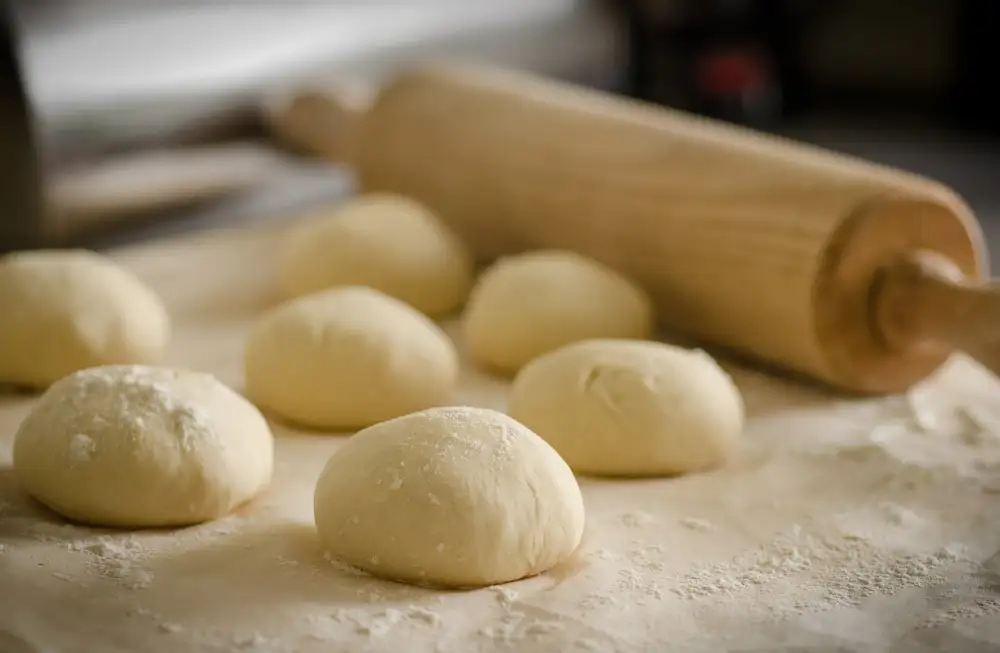Master the Art of Dutch Oven Bread: A Delectable Recipe for Perfectly Baked Bread

- Benefits of Baking Bread in a Dutch Oven
- Choosing the Right Dutch Oven for Baking Bread
- Essential Ingredients for Dutch Oven Bread
- Step-by-Step Instructions for Making Dutch Oven Bread
- Tips and Tricks for Perfect Dutch Oven Bread
- Variations and Additions to Enhance Your Dutch Oven Bread
- Serving and Enjoying Your Homemade Dutch Oven Bread
Baking bread is an art form that has been perfected over centuries. And if you're looking to elevate your baking skills, there's no better way to do it than with Dutch oven bread. This traditional method of baking produces a loaf that is crusty on the outside and soft and fluffy on the inside. The secret lies in the Dutch oven, a heavy pot with a tight-fitting lid that creates the perfect environment for baking bread. In this article, we will explore the benefits of baking bread in a Dutch oven, how to choose the right one, essential ingredients, step-by-step instructions, tips and tricks, variations and additions, and finally, how to serve and enjoy your homemade Dutch oven bread. Get ready to take your baking skills to new heights with this delectable recipe for perfectly baked bread!
Benefits of Baking Bread in a Dutch Oven
Baking bread in a Dutch oven offers numerous benefits that elevate the quality of your homemade bread. Firstly, the heavy and thick walls of the Dutch oven create a perfect environment for even heat distribution, resulting in a beautifully golden and crispy crust. Secondly, the tight-fitting lid traps steam inside the pot, creating a moist and tender interior with a soft crumb. This combination of crusty exterior and soft interior is what makes Dutch oven bread truly exceptional. Additionally, the preheating process allows for excellent heat retention, ensuring consistent baking temperatures throughout. The Dutch oven also acts as a mini-oven within your oven, allowing the bread to bake evenly without any hot spots. These advantages make baking bread in a Dutch oven an excellent choice for achieving professional-level results at home.
Choosing the Right Dutch Oven for Baking Bread
When it comes to baking bread in a Dutch oven, choosing the right one is crucial. The ideal Dutch oven for bread baking is made of cast iron or enameled cast iron. These materials retain and distribute heat evenly, ensuring that your bread bakes evenly and develops a crispy crust.
Look for a Dutch oven with a tight-fitting lid to trap steam during baking. This steam helps create a moist environment inside the pot, resulting in a beautifully risen loaf with a soft interior.
Size-wise, opt for a Dutch oven that can comfortably accommodate the size of your bread dough. A 5-6 quart Dutch oven is usually sufficient for most recipes.
Consider the shape of the Dutch oven as well. Round or oval-shaped pots are commonly used for bread baking as they mimic the shape of traditional artisan loaves.
Lastly, ensure that your chosen Dutch oven is safe to use at high temperatures, typically up to 450°F (230°C). This will allow you to bake bread at higher temperatures without worrying about damaging the pot.
By selecting the right Dutch oven, you set yourself up for success in achieving perfectly baked bread with a golden crust and tender crumb.
Essential Ingredients for Dutch Oven Bread
To create a delicious loaf of Dutch oven bread, you'll need just a few simple ingredients. Here's what you'll need to gather before you begin:
1. Flour: Choose high-quality all-purpose flour or bread flour for the best results. These flours have a higher protein content, which helps to develop gluten and create a chewy texture.
2. Water: Use room temperature water to activate the yeast and hydrate the dough. Avoid using hot water as it can kill the yeast.
3. Yeast: Active dry yeast or instant yeast both work well for baking bread in a Dutch oven. Follow the instructions on the package for proper activation.
4. Salt: Salt not only adds flavor but also helps to control fermentation and strengthen the gluten structure.
That's it! With just these four essential ingredients, you're ready to start making your own mouthwatering Dutch oven bread.
Step-by-Step Instructions for Making Dutch Oven Bread
1. Start by combining 3 cups of all-purpose flour, 1 ½ teaspoons of salt, and ¼ teaspoon of active dry yeast in a large mixing bowl.
2. Slowly add 1 ½ cups of warm water to the dry ingredients, stirring with a wooden spoon until a sticky dough forms.
3. Cover the bowl with plastic wrap and let it sit at room temperature for at least 12 hours, allowing the dough to rise and develop flavor.
4. After the resting period, preheat your oven to 450°F (230°C) and place a Dutch oven with its lid on inside to heat up.
5. Meanwhile, generously flour a clean surface and transfer the risen dough onto it. Gently shape it into a round loaf by folding the edges towards the center.
6. Carefully remove the hot Dutch oven from the oven and take off its lid. Sprinkle some flour or cornmeal on the bottom to prevent sticking.
7. Place the shaped dough into the Dutch oven, seam side down. Cover it with the lid and return it to the preheated oven.
8. Bake for 30 minutes covered, then remove the lid and continue baking for an additional 15-20 minutes until golden brown and crusty.
9. Once baked, carefully remove the bread from the Dutch oven using oven mitts or tongs. Transfer it to a wire rack to cool completely before slicing.
Follow these simple steps to achieve a beautifully baked loaf of bread using your Dutch oven. The result will be a crusty exterior with a soft and chewy interior that is sure to impress your family and friends!
Tips and Tricks for Perfect Dutch Oven Bread
1. Preheat the Dutch oven: To ensure a crispy crust, preheat your Dutch oven along with the oven. This will create a hot environment for the bread to bake evenly.
2. Use parchment paper: Line the bottom of the Dutch oven with parchment paper before placing the dough inside. This will prevent sticking and make it easier to remove the bread once it's baked.
3. Score the dough: Before baking, use a sharp knife or razor blade to make shallow cuts on top of the dough. This allows steam to escape during baking, resulting in a beautiful, crackly crust.
4. Don't peek: Resist the temptation to open the oven door while your bread is baking. Opening it can cause temperature fluctuations and affect how well your bread rises and develops its crust.
5. Let it cool: After removing your bread from the Dutch oven, allow it to cool completely on a wire rack before slicing into it. This will help retain moisture and ensure a better texture.
6. Experiment with steam: For an extra crispy crust, you can create steam in your oven by placing a tray of water on a lower rack while preheating. The steam helps develop that coveted artisanal crust.
Remember, practice makes perfect! Don't be discouraged if your first few attempts aren't exactly what you hoped for. With time and experience, you'll master the art of Dutch oven bread and enjoy delicious homemade loaves every time!
Variations and Additions to Enhance Your Dutch Oven Bread
1. Herbs and Spices: Add a burst of flavor to your bread by incorporating herbs and spices. Try adding rosemary, thyme, or garlic powder for a savory twist. For a touch of sweetness, experiment with cinnamon or nutmeg.
2. Cheese: Take your bread to the next level by adding cheese. Cheddar, Parmesan, or Gruyere can be grated and mixed into the dough for a cheesy delight. The melted cheese will create pockets of gooey goodness throughout the bread.
3. Nuts and Seeds: For added texture and nutrition, consider adding nuts or seeds to your dough. Walnuts, almonds, sunflower seeds, or flaxseeds can be mixed in before baking. They will provide a delightful crunch and enhance the overall taste.
4. Dried Fruits: To infuse your bread with natural sweetness, incorporate dried fruits such as raisins, cranberries, or apricots into the dough. Soak them in warm water before adding to ensure they stay moist during baking.
5. Whole Grains: Boost the nutritional value of your bread by using whole grain flours like spelt or rye instead of all-purpose flour. You can also add cooked quinoa or bulgur wheat for added texture and fiber.
Remember to adjust the quantities accordingly when adding these variations to maintain the right consistency of the dough. Experiment with different combinations to discover your own unique twist on Dutch oven bread!
Serving and Enjoying Your Homemade Dutch Oven Bread
Once your homemade Dutch oven bread is out of the oven and has cooled slightly, it's time to serve and enjoy this delectable treat. The crust should be golden brown and crispy, while the inside remains soft and fluffy.
To serve, you can slice the bread into thick slices or tear it apart for a rustic presentation. Pair it with butter or your favorite spreads like jam, honey, or even cheese for a savory twist. The aroma of freshly baked bread will fill your kitchen, enticing everyone to gather around and savor each bite.
Dutch oven bread is perfect for any mealtime. Enjoy it as a side dish with soups, stews, or salads. It also makes a delightful addition to breakfast when toasted and topped with avocado or eggs. You can even use it to make sandwiches for lunch or as a base for bruschetta during cocktail hour.
Remember that homemade Dutch oven bread is best enjoyed fresh on the day it's baked. However, if you have leftovers, store them in an airtight container at room temperature for up to two days. To reheat the bread and restore its crusty texture, simply place it in a preheated oven at 350°F (175°C) for about 5-10 minutes.
Serving your homemade Dutch oven bread not only satisfies your taste buds but also brings people together around the table. So go ahead and share this delicious creation with family and friends – they'll be impressed by your baking skills!
In conclusion, mastering the art of Dutch oven bread is a game-changer for any home baker. The unique cooking method and the benefits it offers truly elevate your baking skills to a whole new level.
By using a Dutch oven, you can achieve that coveted crispy crust and soft, airy interior that professional bakers strive for. The steam created within the pot during baking helps to create the perfect environment for bread to rise and develop its characteristic texture.
Not only does baking bread in a Dutch oven produce exceptional results, but it also allows for endless creativity. You can experiment with different flours, add-ins, and toppings to create unique variations of your favorite loaf.
The process of making Dutch oven bread may seem intimidating at first, but with practice and patience, you will soon become a master. Follow the step-by-step instructions carefully and don't be afraid to make adjustments along the way.
Once you've baked your first loaf of homemade Dutch oven bread, you'll never want to go back to store-bought again. The satisfaction of pulling a perfectly golden loaf out of the oven is unmatched.
So why not take your baking skills to new heights? Invest in a quality Dutch oven and start exploring the world of artisanal bread-making. With time and practice, you'll be able to impress family and friends with your delicious creations.
Remember, there's nothing quite like the aroma of freshly baked bread wafting through your kitchen. So go ahead, embrace the art of Dutch oven bread and elevate your baking skills today!
Published: 30. 11. 2023
Category: Food



